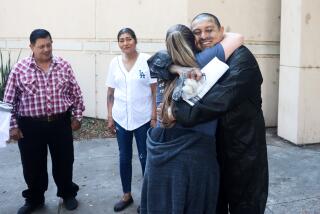Landis, 4 Others Not Guilty in ‘Twilight Zone’ Deaths
- Share via
A jury found “Twilight Zone” director John Landis and four associates innocent of involuntary manslaughter Friday for the movie set deaths of actor Vic Morrow and two children nearly five years ago.
The Superior Court jury had deliberated for nine days after the 10-month trial of Landis, associate producer George Folsey Jr., production manager Dan Allingham, special effects coordinator Paul Stewart and Dorcey Wingo, pilot of the helicopter that crashed in a firestorm, decapitating Morrow and one of the children and crushing the other.
It was Hollywood’s first criminal trial resulting from deaths on a movie set, and the case was watched anxiously in the film community, where it was viewed as an indictment of safety standards.
All five defendants sat motionless as the clerk read the verdicts. Landis’ wife, Deborah, wept softly. Some of the lawyers and defendants patted each other on the back.
“I’m very grateful to the jury and very appreciative to their patience in my trial,” Landis said later. “A truly terrible, tragic accident happened on set of the ‘Twilight Zone.’ This has changed my life and the lives of others. This (the verdict) doesn’t change that. I’m grateful to the jury.”
“This is a wonderful time,” Wingo said as the defendants left court. “I wish we could get the jurors close for a minute; I would like to kiss half of them and hug the rest.”
If convicted, Landis, Folsey and Allingham could have been sentenced to six years in prison, while Stewart and Wingo could have received five-year terms.
Prosecutor Lea Purwin D’Agostino shook her head slightly as clerk Sylvia Feline read the words “not guilty” 15 times, enumerating all the charges.
“I’m shocked, appalled and disappointed,” said D’Agostino, who said that her case was hampered because Hollywood film industry witnesses were reluctant to testify for fear of being blackballed. She praised director and former child actor Jackie Cooper for having the courage to do so.
“(But) if we have succeeded in saving one life, and deterring one director . . . then the prosecution was successful,” she said.
In closing arguments, D’Agostino said all five movie makers were guilty of criminal negligence, but she reserved her most vitriolic attacks for Landis, whom she denounced as a liar and “a tyrannical dictator” who risked disaster in his quest for cinematic realism.
Landis’ attorney, James Neal, who had argued that the deaths resulted from an unforeseeable accident, called the verdicts “wonderful,” and said: “I think they are richly deserved.”
Hushed Courtroom
Asked whether he thought the outcome would have any impact on Hollywood movie making, Neal said: “Hollywood wasn’t really on trial here; it was the way this movie was planned. I haven’t seen that Hollywood is an industry in which recklessness is practiced and I don’t think that will change.”
The courtroom was hushed as Superior Court Roger Boren took the bench and asked the jury foreman, Lois Rogers, if the panel had reached a verdict.
“Yes, we have, your honor,” she said, standing up and holding up a large manila envelope filled with verdict forms.
The judge then spent a tense two minutes examining the forms, declared that they were in order and instructed the clerk to read the verdicts.
Court Sent Word
The defendants and their attorneys had rushed to the courthouse Friday afternoon after the court sent word that a verdict had been reached. They had deliberated a total of 32 hours over nine days, but half of that time was spent listening to a rereading of testimony.
The jury’s action ended nearly five years of complex litigation and an acrimonious trial stemming from the tragedy that struck at 2:20 a.m. on July 23, 1982, a warm summer night at the suburban Indian Dunes movie location 35 miles north of downtown Los Angeles.
It was to be the last night of shooting for a segment of “Twilight Zone: The Movie,” a compilation of eerie stories loosely based on Rod Serling’s classic television series. Each story was interpreted by a different director drawn from Hollywood’s brain trust of bright young film makers, including Steven Spielberg, who produced the film.
In the segment directed by Landis, the 53-year-old Morrow, portraying a bigot, was transformed by a number of life-altering experiences including involvement in the Vietnam War. In the climactic scene, he was to hoist two Vietnamese children under his arms and slog across a river as bombs exploded around them and a helicopter, hovering overhead, opened fire with machine guns.
Physically Jolted
Some of those on the set that night came forward later to describe a scene of such explosive power that it jolted them physically.
Firefighter Jack Rimmer, on hand to fight potential blazes on the set, recalled how the helicopter crashed in a virtual firestorm, strewing pieces of bodies in its wake.
“There was too much of a firestorm,” he testified. “The helicopter blades were kicking up dust and debris. You couldn’t see anything.”
When the smoke cleared, he recalled, he rushed to the downed helicopter and began pulling out passengers. Then he saw the bodies.
Families Sued
Morrow and 7-year-old Myca Dinh Lee had been decapitated. Renee Chen, 6, was crushed to death.
There were immediate reports that the children had been working illegally, that the helicopter had hovered too low, that the bomb blasts were too large. Agencies began probes, and the families of the victims sued.
It was nearly a year before indictments were issued. In one of many ironic twists in the case, the defendants were arraigned and pleaded innocent on June 24, 1983, the same day “Twilight Zone: The Movie” opened in theaters nationwide.
There followed book-length legal briefs seeking dismissal and a preliminary hearing that turned into a mini-trial, but eventually judges and appeals courts unanimously agreed that the film makers should face a jury.
Attorneys Clash
The trial, which opened last July, pitted seven high-powered defense lawyers against a prosecutor whose flashiness and sense of a personal mission to convict the defendants infuriated her opponents and led to unseemly name calling. One defense lawyer called her “scum.” Another said she had “the IQ of a radish.”
D’Agostino called 71 witnesses, from the children’s grief-stricken parents to members of the movie crew.
She took jurors on field trips to the location and to movie studios where they viewed the prosecution’s most powerful evidence--a film of the fiery disaster shot by six cameras.
One key witness, production secretary Donna Schuman, quoted Landis and Folsey as suggesting before the accident that they could go to jail for using the children illegally in the explosive scene.
Matter Ordered Closed
Defense attorneys tried to challenge her testimony with the help of a former investigator on the case, Deputy Dist. Atty. Gary Kesselman, who differed with Shuman on whether she had told him about the statements. The matter was finally ordered closed by the judge after months of wrangling outside the jury’s presence, and jurors heard from Kesselman briefly during the defense case.
But during deliberations, the first testimony jurors asked to hear again was that of Schuman and Kesselman.
The defense called 16 witnesses, including Landis and Wingo, who portrayed themselves as careful and safety-conscious.
Landis frequently choked with emotion as he recalled the deaths and said he would never film such a scene again.
Wingo, acknowledging that “Twilight Zone” was his first feature film, defended his record as an Army pilot in Vietnam as preparing him for the scene.
He startled trial participants by blurting out at one point that he believed Morrow could have saved himself and the children had he kept his eye on the helicopter and jumped out of the way in the five seconds before it crashed.
More to Read
Only good movies
Get the Indie Focus newsletter, Mark Olsen's weekly guide to the world of cinema.
You may occasionally receive promotional content from the Los Angeles Times.










